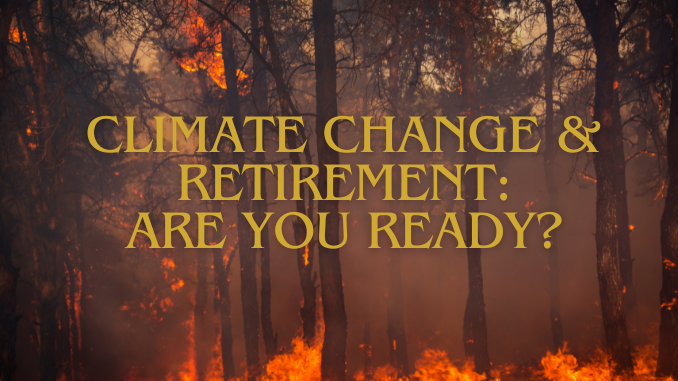
Retirement is a significant milestone in life, and for many, it marks the beginning of a new chapter filled with relaxation, enjoyment, and adventure.
However, as we navigate the age of climate change, retirees need to take some extra precautions when considering their housing options.
Extreme weather events, rising temperatures, and natural disasters are becoming more common, and it’s essential to plan for these challenges to ensure a safe and comfortable retirement.
How to Prepare for Climate Change in Retirement
- Check For Insurance Coverage
Before settling into your retirement location, reach out to your home insurance agent to assess your coverage for natural disasters specific to the area.
Keep in mind that standard homeowners’ policies may not cover all risks, such as flood and earthquake damage. Working with an independent insurance agent can help you tailor your coverage to meet the unique challenges of your chosen retirement spot.
Work with a knowledgeable real estate agent to identify locations and communities that will work for you. Investigate available disclosures that are property-specific.
We can’t stress this enough: It is very important to check on a property’s insurability and costs before even making an offer to purchase a property for retirement.
Useful links to research a property’s hazard risks:
Check the CalFire map here to see if the property you are interested in is in very high, high, or moderate fire hazard severity zone. This will also show the responsibility area (whether local, state, or federal).
Read and understand the Natural Hazard Disclosure Report (NHD) usually provided by the seller during the escrow process as part of your due diligence.
Riskfactor.com – This website allows anyone to look up flood, fire, wind, and heat risk factors for a specific property address.
ClimateCheck.com – ClimateCheck® ratings reflect hazard risk at a property relative to the rest of the contiguous United States based on Drought, Fire, Heat, Storm, Flood Risks.
- Consider Vacationing for an Extended Period or Renting First
Instead of buying property right away, consider vacationing or renting first. Vacationing to your desired location for a few months allows you to feel more of a local while keeping your home and doing your research. Renting allows you to get a feel for your retirement location, manage your finances, and assess whether additional property insurance is necessary and worth the investment. This approach gives you the flexibility to adapt as needed.
- Utilize Climate Risks Data and Analysis
Stay informed about the climate risks in your retirement area. Certain companies mentioned in the links below provide valuable data and tools to help communities adapt to changing climate conditions.
FEMA’s new map for natural hazards can be a helpful resource.
Additionally, organizations like The Hartford and MIT’s AgeLab collaborate on awareness campaigns for seniors and disasters.
Some of the tips from MIT’s AgeLab include:
* Know which disasters you’re at risk for and how to best prepare for them
* Plan for the possibility that you may have to evacuate your home
* Set up your support network: family, friends, neighbors
* Evaluate the risks, abilities and needs of everyone in your household and adjust your plan accordingly
* Make a plan for your pets
Belongings: Know Them!
* Create a home inventory. Start by going room to room with a video or still camera to make a visual record of your belongings
* Prepare a written list to accompany your visual record
* Keep receipts for valuable items and write on your inventory list their make, model, serial number, date of purchase, and other relevant information
* Store a copy of whatever documentation you create away from your home
* Update the inventory periodically
More Online Resources for Climate Change in Assessing Property Risks:
Riskfactor.com – This website allows anyone to look up flood, fire, wind, and heat risk factors for a specific property address.
ClimateCheck.com – ClimateCheck® ratings reflect hazard risk at a property relative to the rest of the contiguous United States based on Drought, Fire, Heat, Storm, Flood Risks.
Fortress Fire – Fotress Fire’s Wildfire Disclosure Report (WFDR) combines satellite imagery, machine learning, and advanced physics models to provide objective data on property-specific vulnerabilities. It incudes fuel load analysis, topographical insights, and proximity to Fire-Prone Areas.
- Develop an Emergency Plan
Protecting your property is vital, but saving your life is even more critical. Consider how you’ll evacuate to safer areas if necessary, especially if you or your loved ones have mobility issues. Even in cities well-prepared for climate-related disasters, ensuring the safety of vulnerable citizens remains a challenge. Plan and prepare for your evacuation if the need arises.
- Protect Your Property
Consider taking preventive measures to limit disaster risk. Some regions, like California, have statewide codes for protecting homes in fire-prone areas, such as maintaining safe distances from trees and shrubs and using fire-resistant construction materials.
Check whether your county or city has similar codes in place, and explore the International Code Council and National Fire Protection Association wildland-urban interface fire codes for adaptable local solutions.
Additionally, invest in fire-resistant roofing materials, exterior sprinklers, fire blankets, and foam for added protection.
According to this report, roofing is one of the most important ways to protect a structure from wildfire. The following are noncombustible roof coverings:
- cement shingles or sheets
- exposed concrete slab roof
- ferrous or copper shingles or sheets
- slate shingles
- clay or concrete roofing tile
- approved roof covering of noncombustible material
When assessing your home, or a property that you are interested in to purchase, take a look at fuel sources around it. They could be wood chips near the house, wild land dry vegetation surrounding the property. Even furniture and combustible materials in the garden or yard pose risk.
- Address Extreme Heat
If you plan to retire in a region with hot summers, prepare for more frequent heatwaves. Extreme heat can be especially dangerous for older individuals, so ensure your home is equipped with efficient air conditioning. If you need to replace your old unit, consider energy-efficient models. Investing in a battery-run power generator may also be a wise choice to handle power outages during heatwaves.
Budgeting for Climate Change
Higher property insurance costs
Costs are increasing to insure a property. There is also a possibility when insurers exit a market leaving homeowners with no insurance! At the time of this writing, major insurers have ceased writing new business in California (State Farm Insurance stopped in May 2023) and are requesting the state to allow them to raise rates before they even consider entering the market again. If granted by the state, it is likely that all insurers will also be rewarded with higher rates to charge their customers.
The rising costs of home insurance in California
Utility bills
If a retiree chooses a retirement location that tends to have higher heating and cooling utility bills, they need to think twice and consider overall monthly costs when choosing a cheaper location of a home with hotter summers and colder winters vs. other locations with milder climate.
Climate Change and Real Estate
For retirees who are looking to find their forever home, or even assessing whether they can age-in-place in their current home, they may want to consider climate change factors as they could affect a retiree’s sense of safety, comfort, health, and financial budget (rising costs of insurance, utility bills, home maintenance and repairs).
Climate Change and Real Estate Disclosures
In California, some properties are subject to AB 38 Compliance: Wood. Fire safety: low-cost retrofits: regional capacity review: wildfire mitigation.
Sellers of properties within State Responsibility Areas (SRAs) with a CalFire Fire Hazard Severity Zone (FHSZ) rating of ‘High’ or ‘Very High’ or in Local Responsibility Areas (LRAs) with a CalFire FHSZ rating of ‘Very High’ must provide buyers with documentation that the property complies with defensible space requirements (AB 38).
Lookup a property’s location on CalFire Map to see if it is in a high fire severity zone.
Read: How defensible space is affecting real estate
Where to Retire in the Age of Climate Change
While it’s important to be prepared for climate change, choosing a suitable retirement location can also make a significant difference.
Of course climate change is not the sole factor in deciding where to retire in the U.S. Affordable home prices and budget play a role. Just as important might be; i.e. living close to where family is, or where one’s job/business is currently located.
Some areas are better equipped to handle climate challenges than others.
You might choose to retire in the Pacific Northwest, northern Rockies, and water-rich mid-South; but know that any location in the U.S. will not be entirely immune to global climate change.
Coastal Florida might be an attractive place for retirees in the U.S. with a combination of beautiful beaches and warm weather not to mention favorable taxes. However, consider coastal locations carefully due to hurricane and rising sea level risks. The rising costs of insurance is also making Florida not as budget-friendly anymore.
The Southwest states like Arizona and Nevada, including inland parts of Southern California (i.e. Riverside County) offer a dry climate and plenty of sunshine. These regions are less prone to hurricanes and flooding so have attracted many retirees. But extreme heat is something to contend with.
Pacific Northwest states like Oregon and Washington offer a milder climate, making them attractive for retirees. However, recent heatwaves in the region highlight the importance of preparing for extreme heat.
California, especially Southern California, and more specifically, San Diego County and Orange County, are very attractive to retirees for its weather and natural beauty. But rising home prices and low inventory are to be reckoned with in addition to wildfire and earthquake risks that exist. Not all of San Diego County is the same. Some areas experience higher temperatures. Even a few degrees of higher temperature can make a difference from one city to another especially in a heat wave. Of course the low-lying coastal areas are subject to rising sea level and flood risks.
It is more important than ever to work with knowledgeable real estate agents to identify which home and community will work for retirees based on their specific search criteria, considerations, risk tolerance, and budget.
References:
The Impact of Climate Change on u.S. Subnational economies

Contact Jean and Ken Tritle, a husband and wife real estate broker/agent team at DreamWell Homes Realty.
Call or Text: 760-798-9024
Email: jeanken@dreamwellhomes.com
